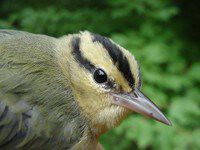|
|
|||
|
THIS WEEK at HILTON POND |
|
"BLACK AND YELLOW" WARBLER Sometimes a bird's everyday name can be a little confusing. There's the Common Nighthawk (which is related to Whip-poor-wills rather than to birds of prey) . . . and the Purple Finch (whose raspberry-colored plumage is pretty far down the spectrum from most folks' idea of "purple") . . . or the Northern Waterthrush (a ground-dwelling warbler that only superficially resembles a spot-breasted Wood Thrush). And then there's the well-known "Black and Yellow Warbler," a bird we've been netting and banding this week at Hilton Pond Center. 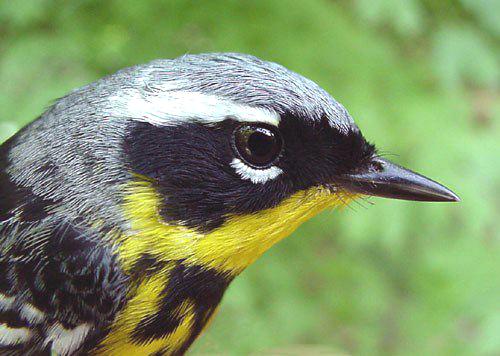
All text & photos © Hilton Pond Center This bird was named by Alexander Wilson, an early ornithologist who first saw and collected two specimens in about 1810 at Fort Adams, Mississippi. In this species, an adult male in breeding plumage (above and below left) is truly one spring bird that will take your breath away, so Wilson's decision to call it "Black and Yellow Warbler" was both understandable and apt. He messed up, however, in giving his bird the scientific name Sylvia magnolia after he had observed a flock of them flitting around in magnolia trees. Unbeknownst to Wilson, the Magnolia Warblers he encountered were spring migrant birds on their way toward Canada--far north of the range of the Southern Magnolia tree in which he first saw them. Wilson would have served science better had he called the species something like Sylvia sprucea, the Spruce Warbler, for in Canada and the northeastern U.S. it is young spruce, fir, and hemlock trees that offer prime breeding habitat for the species. ( All this aside, Magnolia Warblers do come through the Carolina Piedmont during migration, and we're always glad to see them at Hilton Pond Center. Adult males in spring are breathtaking, with black streaking on a brilliant yellow breast, jet-black mask and upper back, yellow rump, and a wide white bar that stands out against the bluish-gray wing. Breeding females resemble males, but with less black. The most unusual mark borne by every Magnolia Warbler is a large white band that nearly bisects the tail (above right). Thus, if an unidentified warbler is perched high above it only has to fan its tail to confirm it is a Magnolia. This distinctive tail mark is a blessing for beginning birders, especially in fall when Magnolia Warblers pass through heading south. By then adults have lost their bright breeding plumage and young birds are plainer still, so any of them can be "confusing fall warblers." We catch Magnolia Warblers primarily in fall migration. Of the 356 individuals banded at Hilton Pond Center since 1982, about 85% of them have been netted from August through October. Most probably originated in the boreal forests of Canada, but Magnolia Warblers also breed regularly down the Appalachians as far southwestern Virginia--and even at higher elevations in Tennessee and the Carolinas. The Breeding Bird Survey map (below right), depicts the Magnolia Warblers' nesting range, with darker colors indicating greater density. (Although not indicated on the map, the species also breeds in good numbers across Newfoundland.) Spring migration of Magnolia Warblers goes by in a flash at Hilton Pond Center, covering only the last week in April and first week in May. By comparison, fall migration is long and drawn out. During both spring and fall migration, our local Magnolia Warblers hang out in the subcanopy, eating caterpillars from undersides of leaves on various trees and shrubs. Good thing Alexander Wilson didn't have his first experience with these colorful birds at Hilton Pond Center, else he might have named them Sylvia cornusulmusliquidambara--the "Dogwood-Elm-And-Sweetgum" Warblers. If you enjoy "This Week at Hilton Pond," please help Support Hilton Pond Center for Piedmont Natural History. It's painless, and YOU can make a difference! Map courtesy of U.S. Geological Survey's Breeding Bird Survey. You may wish to consult our Index of all nature topics covered since February 2000. |

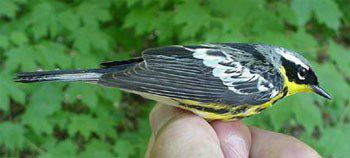 This poorly chosen technical epithet led to the modern-day common name of Magnolia Warbler, which misleads birders even more.
This poorly chosen technical epithet led to the modern-day common name of Magnolia Warbler, which misleads birders even more.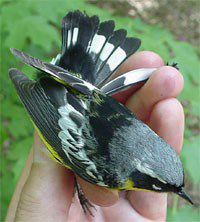 To further confuse things, the Magnolia Warbler's technical name was changed from Sylvia magnolia to Dendroica magnolia--which reflects the bird's close genetic relationship to such birds as D. coronata, the Yellow-rumped Warbler, and the Yellow-throated Warbler, D. dominica--but doesn't clear up the "magnolia issue.")
To further confuse things, the Magnolia Warbler's technical name was changed from Sylvia magnolia to Dendroica magnolia--which reflects the bird's close genetic relationship to such birds as D. coronata, the Yellow-rumped Warbler, and the Yellow-throated Warbler, D. dominica--but doesn't clear up the "magnolia issue.")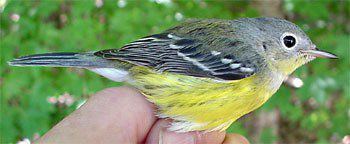 In all ages and sexes of autumn Magnolia Warblers, the breast streaking is lighter, the black mask is lacking, and the wing bar is less prominent, but most immatures have an especially noticeable gray necklace (above left). The Magnolia Warblers we banded this week at Hilton Pond Center each had a wide necklace and pointed tail feathers, so we knew it hatched in the summer of 2002. Indeed, over the past 20 years the vast majority of our migrant Magnolia Warblers have been young of the year.
In all ages and sexes of autumn Magnolia Warblers, the breast streaking is lighter, the black mask is lacking, and the wing bar is less prominent, but most immatures have an especially noticeable gray necklace (above left). The Magnolia Warblers we banded this week at Hilton Pond Center each had a wide necklace and pointed tail feathers, so we knew it hatched in the summer of 2002. Indeed, over the past 20 years the vast majority of our migrant Magnolia Warblers have been young of the year.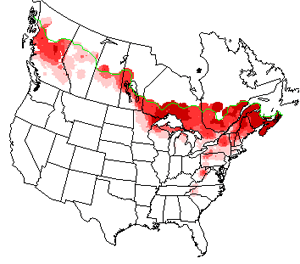 The earliest autumn migrant we have banded was on 31 August, the latest on 21 October--nearly an eight-week span. After leaving here, Magnolia Warblers wing it toward Latin America, spending our winter months primarily from southern Mexico into Panama, and rarely in the Caribbean and northern South America.
The earliest autumn migrant we have banded was on 31 August, the latest on 21 October--nearly an eight-week span. After leaving here, Magnolia Warblers wing it toward Latin America, spending our winter months primarily from southern Mexico into Panama, and rarely in the Caribbean and northern South America.